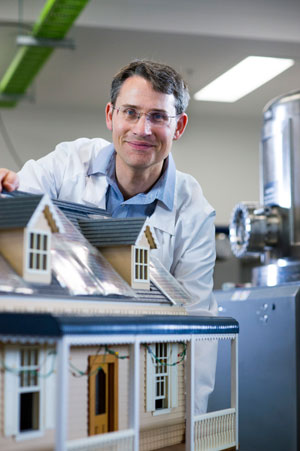
Researchers from the University of Newcastle (UON) and the University of Cambridge (UK) have successfully collaborated to create a breakthrough new microscope which opens a new window into the scientific world.

Image credit: www.newcastle.edu.au
The scanning helium microscope (SHeM) uses neutrally charged helium instead of light – which can destroy certain samples due to its electric charge – to allow delicate materials to be accurately imaged for the first time.
“Delicate structures such as biological samples suffer degradation under existing microscopes, which means the very act of observation destroys or changes the properties of the samples we are trying to study – it’s quite a paradox,” said Associate Professor Paul Dastoor from the UON, who has been working the new microscope for two decades.
“Helium is able to image sensitive structures with zero damage as it is chemically, electrically and magnetically inert, allowing us to now study many surfaces for the very first time,” Professor Dastoor explained.
He said the technology could be commercially relevant for a broad range of applications and industries, such as defence and healthcare.
“Modern defence forces require new coatings and novel thin films in order to stay competitive in the age of electronic warfare,” he said.
“The new instrument is an ideal tool for investigating new explosives and other high energy materials such as propellants and pyrotechnics that may become dangerously unstable if studied using existing microscopes.”
According to him, the microscope will offer for the first time in mankind’s history the ability to study human samples in their true, unmasked state.
“For instance, we’ve already been able to clearly see the actual structure of a membrane because the helium microscope gives detail not previously available. A traditional microscope sees straight through a membrane. We’ve been able to look at the actual structure,” Mr Dastoor explained.
“The medical and pharmaceutical applications are very exciting. It will enable a new point of view for things like parasites, cell cultures and bacteria.”
Professor Dastoor said the technology could also offer significant benefits for sustainability and the solar energy industry.
“Under the energetic beams of traditional microscopes, many of the new solar cells suffer degradation or even wholesale destruction. The new technology allows us to observe and therefore optimise and progress solar cell technology.”
“The microscope also has vital applications for the automotive industry, such as the removal of carbon monoxide from exhaust gases. Additional sustainability applications include the investigation of nanoparticles as a means to clean up toxic or even radioactive spills without harming the surrounding flora or fauna.”
He said the next challenge was to build a desktop version that could be used in laboratories around the world.
“A smaller version of the SHeM opens the door to a new commercial Australian technology; allowing other scientists access to its unique imaging capabilities,” Professor Dastoor concluded.




















